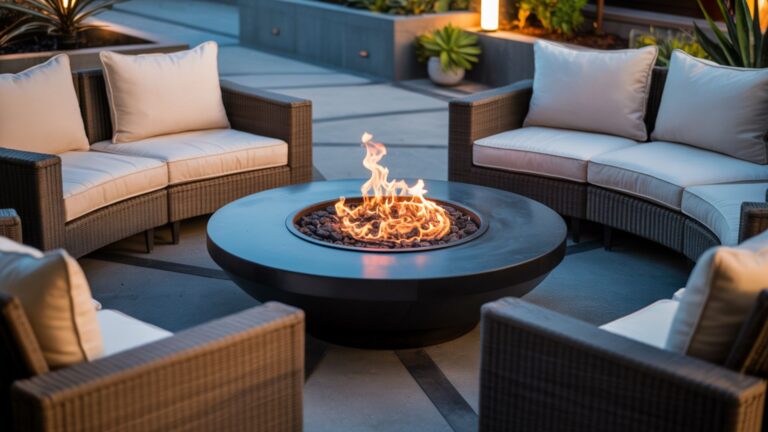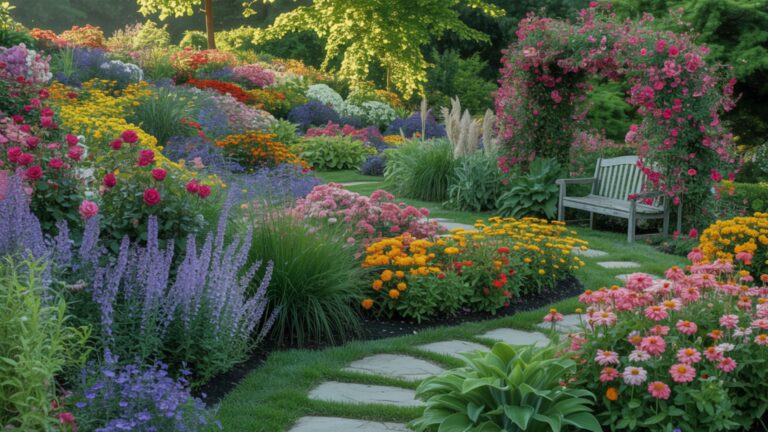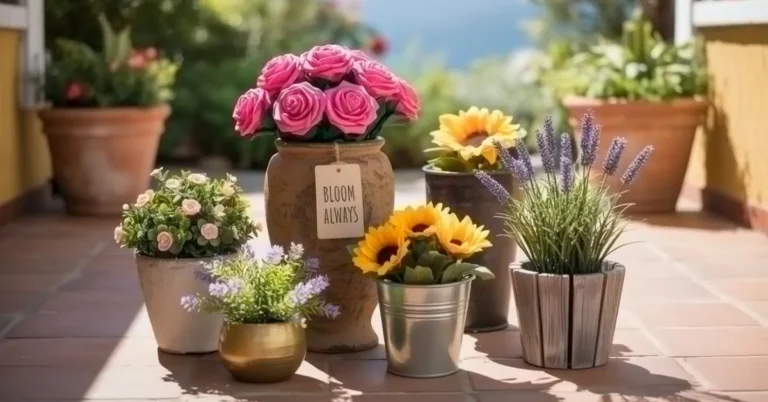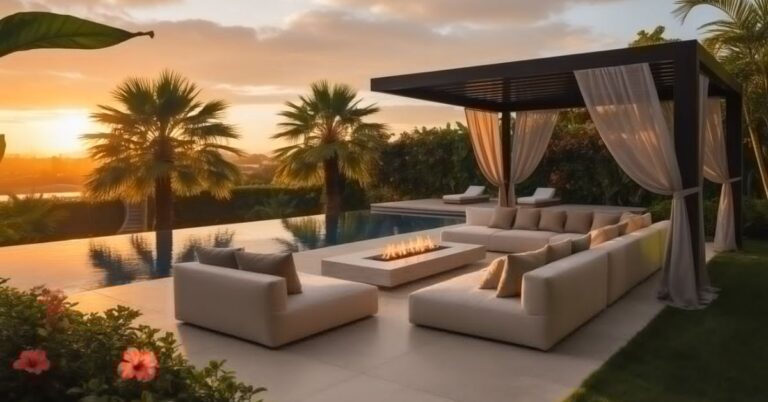47 Stunning Roof Deck Ideas to Transform Your Rooftop Terrace
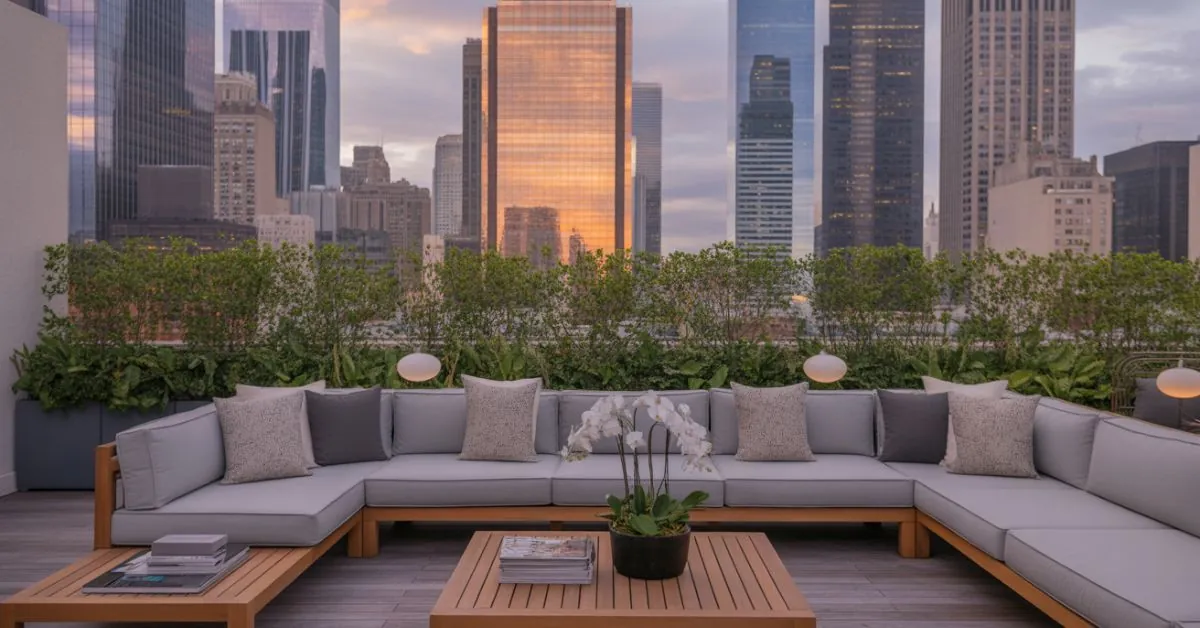
Staring at your empty rooftop wondering how to turn that wasted space into your personal outdoor paradise? You’re not alone. Most urban dwellers struggle with limited outdoor space, watching their rooftops collect dust while dreaming of a private retreat above the city chaos. The frustration builds as you see neighbors enjoying beautifully designed roof deck ideas rooftop terrace spaces while yours remains an unused concrete slab.
Here’s the reality: your rooftop represents the most valuable untapped real estate in your home. With the right rooftop terrace design approach, you can create a stunning outdoor sanctuary that rivals expensive resort destinations. This comprehensive guide reveals 47 proven roof deck ideas that will transform your space into a functional, beautiful extension of your living area regardless of your budget or rooftop size.
Essential Planning Considerations for Your Rooftop Deck Design
Before diving into specific roof deck ideas rooftop terrace designs, understanding the foundational planning elements will save you time, money, and potential headaches. Your rooftop environment presents unique challenges that ground-level patios don’t face.
Wind exposure ranks as the primary concern for most rooftop installations. Unlike protected ground-level spaces, your rooftop terrace will experience wind speeds 2-3 times stronger than street level. This affects everything from furniture selection to plant choices and privacy screen materials. Use a see-through railing with a subtle metal grid or glass panel to ensure safety without compromising your view, which helps manage wind while maintaining the open feeling that makes rooftops special.
Weight capacity determines what materials and features you can safely include in your roof deck ideas. Most residential rooftops support 30-50 pounds per square foot, though this varies significantly based on construction type and age. Consult a structural engineer before adding heavy elements like hot tubs, extensive planters, or stone features. These days, most contractors and homeowners are choosing composite decking for rooftop decks. Our rooftop deck has a capped composite decking, and after living in our home for eleven years, it’s still in great condition and has required minimal maintenance.
Read More About: 50+ Groovy Hippie Garden Ideas to Create Your Love Paradise
What Materials Work Best for Rooftop Deck Construction?
Selecting appropriate materials forms the backbone of successful rooftop terrace projects. Unlike ground-level decks, rooftop installations face extreme temperature fluctuations, intense UV exposure, and constant wind stress.
Wood deck designs look the most natural, but also require the most maintenance, like staining and weatherproofing. Composite, on the other hand, is easier to care for but might not look as authentic. Plastic decking can be a less expensive alternative and removes any risk of splinters. For roof deck ideas rooftop terrace projects, composite materials offer the best balance of durability and aesthetics.
Porcelain tiles provide another excellent option for rooftop terrace flooring. The pergola and privacy screens are a mix of cedar and steel and the flooring tiles are porcelain. These tiles resist freeze-thaw cycles, won’t fade under UV exposure, and create sophisticated looks ranging from natural stone to modern concrete appearances. The pedestal mounting system allows for proper drainage while creating level surfaces over uneven rooftop membranes.
Natural stone works beautifully for accent areas but requires careful weight calculations. Limestone, slate, and granite can create stunning focal points around fire features or dining areas. However, limit stone applications to smaller sections to avoid overloading your roof structure.
Modern Rooftop Terrace Layouts That Maximize Space
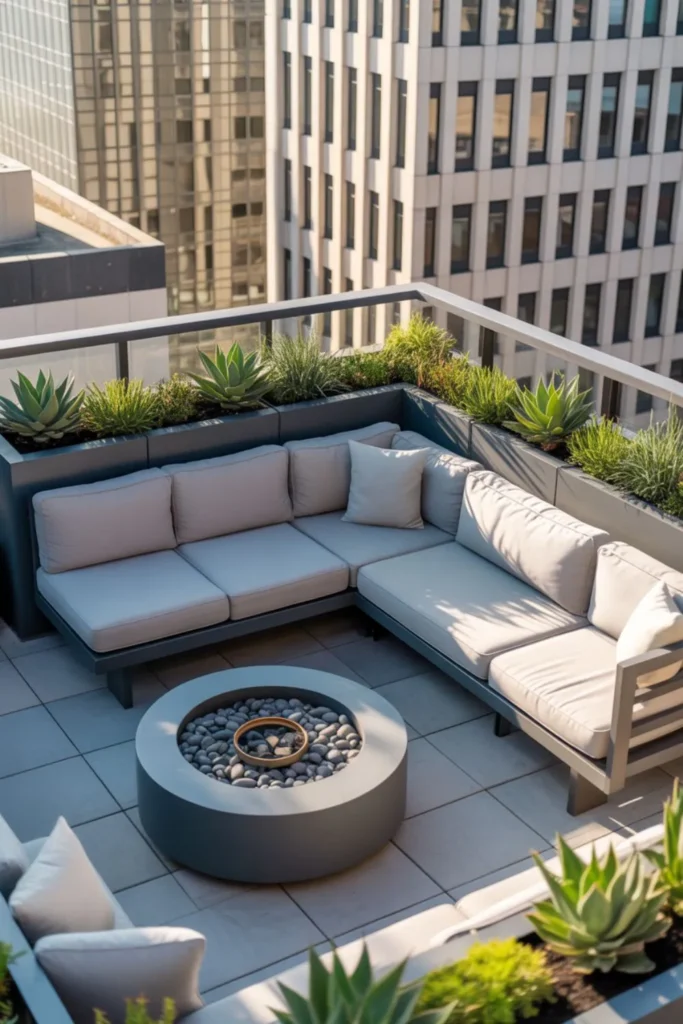
Effective roof deck ideas rooftop terrace layouts create distinct zones that serve different functions while maintaining visual flow. The key lies in understanding how people naturally move through outdoor spaces and designing circulation patterns that feel intuitive.
The L-shaped layout works exceptionally well for rectangular rooftops. Position your primary seating area in one section, with dining or entertainment zones in the perpendicular section. This configuration creates natural privacy between activities while maximizing usable square footage. Use cohesive flooring like wood decking or stone tiles to visually connect the two areas. A glass railing maintains an open feel, while matching outdoor furniture ensures harmony in design.
Multi-level designs add visual interest to larger rooftop terrace projects. Create subtle elevation changes using platform construction or built-in planters as room dividers. A raised dining platform overlooking a sunken lounge area creates dramatic spatial relationships while defining separate functions. These elevation changes also help manage wind flow and create more intimate conversation areas.
Central focal point layouts work beautifully for square or smaller rooftops. Position a fire feature, water element, or sculptural planter in the center, then arrange seating and dining areas around the perimeter. This approach creates natural gathering spaces while ensuring every seat enjoys views of both the focal feature and surrounding cityscape.
Creative Privacy Solutions for Urban Rooftop Decks
Successful roof deck ideas for planting require understanding the extreme growing conditions that plants face at elevation. Choosing the right plants is crucial because your selections determine whether greenery thrives or merely survives on your rooftop. Smart roof deck ideas always balance aesthetics with functionality, ensuring that your green elements enhance the space instead of struggling against the environment.
Bamboo, ferns, boxwood shrubs, and floral vines are popular choices in privacy-focused roof deck ideas. For those who prefer a low-maintenance option, fake green walls deliver the same lush appearance without the upkeep. Arranging multiple pots at varied heights creates full coverage, and these clever roof deck ideas add both texture and depth. However, long-term success always depends on choosing plants specifically adapted to rooftop conditions.
Wind-resistant greenery forms the foundation of sustainable roof deck ideas. Ornamental grasses like fountain grass, blue fescue, and feather reed grass bend gracefully under strong winds, while succulents such as sedums, echeveria, and agave thrive in both drought and windy rooftop environments. These plant-driven roof deck ideas are not only durable but also visually dynamic, with groundcovers spreading naturally to stabilize planters.
Container selection is another critical element in well-designed roof deck ideas. Deep containers with at least 18 inches of soil provide root space and thermal mass that moderates temperature fluctuations. Larger planters also reduce watering frequency, while grouping containers into clusters creates protective microclimates. These thoughtful roof deck ideas ensure that plants stay healthy despite rooftop challenges.
Vertical growing systems expand planting capacity without consuming valuable floor space, making them some of the most innovative roof deck ideas. Wall-mounted pocket planters, tiered containers, and trellis-integrated designs create striking green walls that maximize greenery. These space-saving roof deck ideas work especially well for herbs, small vegetables, and annual flowers that benefit from easy access and regular care.
Plant Selection Strategies for Rooftop Gardens
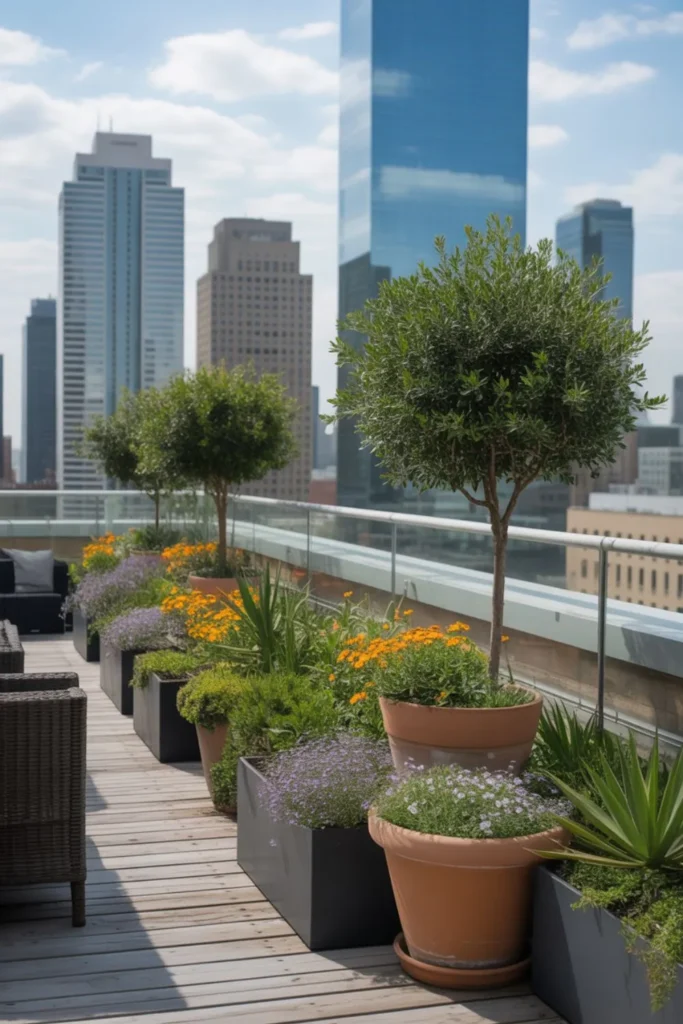
Successful roof deck ideas for planting require understanding the extreme growing conditions plants face at elevation. Your plant selections determine whether greenery thrives or merely survives, and the most effective roof deck ideas always account for wind, heat, and limited soil depth.
Bamboo, ferns, boxwood shrubs, and floral vines are among the most popular plant choices in privacy-driven roof deck ideas. For homeowners who prefer low-maintenance solutions, fake green walls provide the same lush appearance without the upkeep. Arranging pots at varied heights adds layered coverage, while smart roof deck ideas always emphasize plants adapted to rooftop conditions for long-term success.
Wind-resistant greenery forms the backbone of durable roof deck ideas. Ornamental grasses such as fountain grass, blue fescue, and feather reed grass bend gracefully under strong winds, while succulents like sedums, echeveria, and agave thrive in both drought and high wind. Low-growing groundcovers add resilience, making them practical choices in plant-focused roof deck ideas.
Container selection also shapes successful roof deck ideas. Deep containers at least 18 inches tall provide adequate root space and thermal mass to regulate soil temperature swings. Larger planters reduce watering frequency, and grouping containers into clusters creates microclimates that protect greenery from wind and heat. These strategies are fundamental to functional planting-based roof deck ideas.
Vertical growing systems expand greenery without consuming floor space, making them some of the most space-saving roof deck ideas. Wall-mounted pocket planters, tiered container systems, and trellis-integrated designs create eye-catching green walls. These vertical roof deck ideas are perfect for herbs, small vegetables, and flowers that thrive with easy access and consistent care.
Lighting Design Ideas for Rooftop Evening Enjoyment
Proper lighting extends roof deck ideas rooftop terrace usability well into evening hours while creating magical atmospheres that transform ordinary spaces into extraordinary retreats.
Creating shade and privacy around much of the space, automatically limits access to natural light, a key part of the design was a well crafted lighting plan. While offering functionality and safety, effective rooftop lighting balances ambient, task, and accent illumination layers.
String lights remain popular for good reason they create instant warmth and intimacy. However, choose commercial-grade options designed for permanent outdoor installation. LED string lights consume minimal energy while providing years of reliable operation. Install dimmer controls to adjust brightness levels based on activities and moods.
Adding soft, recessed lighting can enhance the ambiance of your space without overpowering the beauty of your cityscape views. Recessed deck lighting highlights walking surfaces for safety while maintaining subtle elegance. Solar-powered options eliminate wiring complications while providing eco-friendly operation.
Fire features create dramatic focal points while providing natural gathering spaces. Gas fire tables offer convenient operation with consistent flames, while wood-burning fire bowls create authentic ambiance with crackling sounds and aromatic smoke. Always check local regulations regarding open flames on rooftops and install appropriate wind screens.
Uplighting techniques highlight architectural features and plantings dramatically. Well lights positioned beneath trees or large planters create stunning silhouettes against building facades. Wall-washing techniques using linear LED fixtures transform plain walls into impressive backdrops for outdoor dining or entertainment areas.
How Much Does a Rooftop Deck Cost to Build?
Understanding rooftop terrace costs helps establish realistic budgets and prioritize features that provide the best return on investment. Rooftop construction typically costs 25-50% more than ground-level projects due to material transport, access challenges, and specialized installation requirements.
Basic rooftop deck installations start around $15-25 per square foot for simple composite decking over existing flat roofs. This price includes basic framing, composite decking materials, and standard railings but excludes utilities, complex drainage, or custom features. Most homeowners invest $8,000-$15,000 for functional 400-500 square foot rooftop decks.
Mid-range roof deck ideas rooftop terrace projects typically cost $25-45 per square foot. These installations include upgraded materials like porcelain tiles or premium composite decking, basic electrical for lighting, simple irrigation systems, and moderate privacy screening. Expect total costs of $15,000-$35,000 for comprehensive 500-800 square foot spaces.
High-end rooftop terraces can exceed $50-100 per square foot when including luxury features. Custom millwork, premium natural stone, integrated water features, automated irrigation and lighting systems, and substantial structural modifications drive costs into the $50,000-$150,000 range for sophisticated installations.
Professional design fees typically add 10-15% to construction costs but often save money through efficient layouts and material selections. Structural engineering consultations cost $1,000-$3,000 but provide essential safety certifications that protect your investment and ensure code compliance.
Small Rooftop Deck Ideas That Feel Spacious
Compact roof deck ideas rooftop terrace projects require strategic design approaches that maximize perceived and functional space. Small doesn’t mean compromising on style or functionality, it means being more thoughtful about every design decision.
Vertical design elements draw the eye upward, making small spaces feel larger. Install tall planters, vertical gardens, or privacy screens that extend well above head height. This technique creates the illusion of expanded space while providing practical benefits like wind protection and privacy screening.
Multi-functional furniture maximizes utility in limited square footage. Ottoman storage pieces provide seating while hiding cushions and accessories. Fold-down wall tables create dining surfaces that disappear when not needed. Modular seating systems reconfigure for different activities, from intimate conversations to larger gatherings.
Light color palettes reflect more light and create airy feelings. White, cream, and light gray decking materials make spaces feel larger and brighter. Similarly, light-colored furniture and accessories prevent small spaces from feeling cramped or cave-like. Strategic use of mirrors can double perceived space, though wind considerations may limit mirror applications.
Corner optimization utilizes every available square foot effectively. Custom corner seating with built-in storage maximizes seating capacity while providing weather-resistant storage. L-shaped planter arrangements create privacy screens while defining space boundaries. Corner-mounted shade structures provide overhead protection without center support posts that consume valuable floor space.
Read More About: 50+ Groovy Hippie Garden Ideas to Create Your Love Paradise
Weather-Resistant Furniture and Decor Selections
Rooftop environments demand furniture and accessories designed for extreme weather exposure. Standard patio furniture often fails within 1-2 seasons when exposed to constant wind, UV radiation, and temperature extremes that rooftops experience.
Aluminum furniture frames provide the best combination of strength, light weight, and corrosion resistance. Look for powder-coated finishes that resist chipping and fading. Avoid furniture with numerous joints or moving parts that can fail under constant wind stress. Solid, welded construction lasts longer than assembled pieces with multiple fasteners.
All-weather wicker made from synthetic resins looks natural while resisting UV damage and moisture absorption. High-quality synthetic wicker maintains flexibility in temperature extremes and won’t crack or split like natural wicker materials. Choose neutral colors that won’t show fading as obviously as bright or dark colors.
Fabric selections must withstand intense UV exposure and frequent weather changes. Solution-dyed acrylic fabrics like Sunbrella resist fading and mildew while maintaining softness and comfort. These premium fabrics cost more initially but last 3-5 times longer than standard outdoor fabrics. Quick-dry foam cushion cores prevent moisture retention that leads to mold and odor problems.
Weighted bases or secure anchoring systems prevent furniture movement in high winds. Umbrella bases should weigh at least 50 pounds for rooftop applications. Furniture covers protect investments during extreme weather but must be properly secured to prevent wind damage.
Safety Considerations for Rooftop Deck Installation
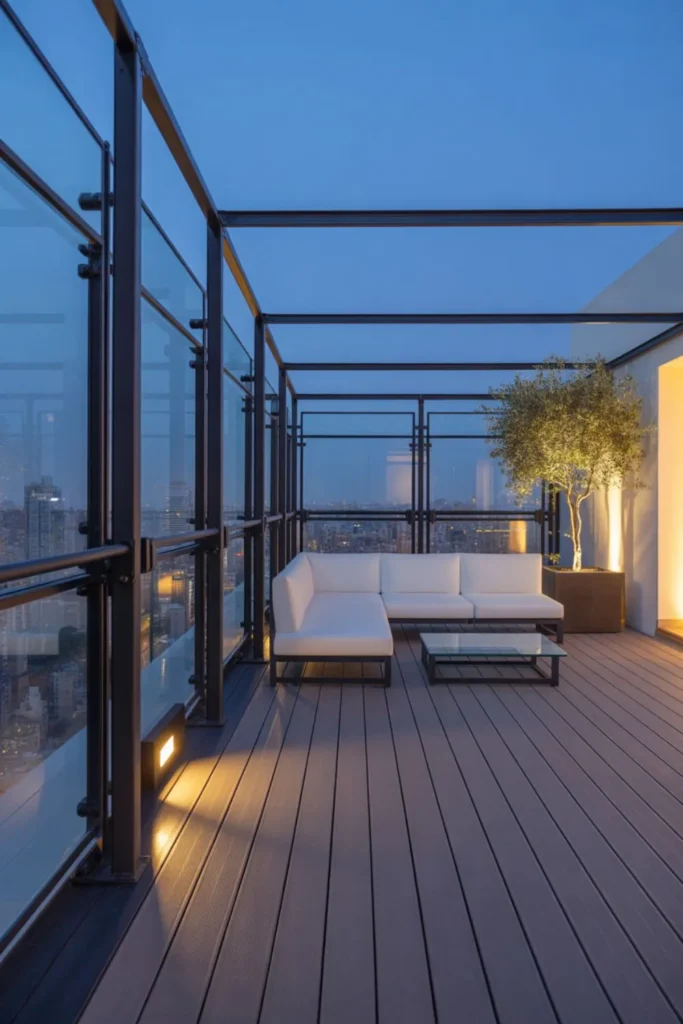
Safety codes and regulations governing rooftop terrace construction vary significantly by location, but certain principles apply universally. Understanding these requirements early prevents costly modifications and ensures your space meets legal standards.
Railing height requirements typically mandate 42-inch minimum heights for rooftop installations, compared to 36 inches for ground-level decks. Wind loading calculations must account for increased wind speeds at elevation. Glass railings require tempered or laminated safety glass rated for your specific wind zone. Cable railings must use aircraft-grade cables with proper tensioning systems.
Fire safety considerations become critical on rooftops where escape routes are limited. Maintain clear egress paths to stairway access points. Fire extinguishers designed for outdoor use should be easily accessible, especially if you include cooking or fire features. Some jurisdictions require sprinkler system extensions for rooftop decks.
Structural load calculations must account for live loads (people, furniture, snow) and dead loads (permanent installations). Most residential roofs support 30-50 PSF, but older buildings or unique constructions may have lower capacities. Hot tubs, large planters, and stone features require specific engineering analysis.
Electrical installations must use GFCI protection and weatherproof components rated for outdoor exposure. All wiring should be protected in conduit and properly grounded. Many jurisdictions require licensed electricians for any rooftop electrical work. Consider 240V service if you plan to add hot tubs or electric heating elements.
Seasonal Rooftop Terrace Maintenance Tips
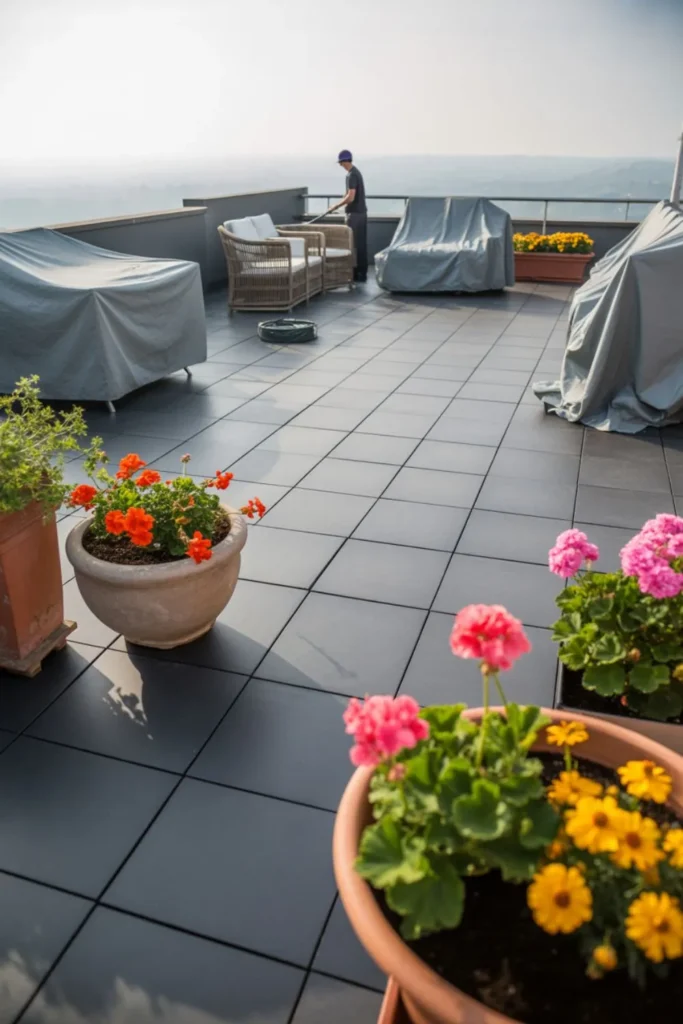
Proper maintenance extends roof deck ideas rooftop terrace lifespan while preserving appearance and safety. Rooftop environments accelerate wear compared to ground-level installations, making consistent maintenance crucial for long-term success.
Spring maintenance focuses on assessing winter damage and preparing for the growing season. Inspect all fasteners, railings, and structural elements for loosening or corrosion. Clean debris from drainage systems and check for proper water flow. Power-wash surfaces to remove winter grime and salt residue. Inspect and test all electrical components before seasonal use.
Summer care emphasizes protecting materials from UV damage and heat stress. Apply protective treatments to wood elements before peak sun exposure. Monitor plant health closely, as rooftop conditions can stress plants quickly during heat waves. Check irrigation systems weekly and adjust watering schedules based on weather conditions. Inspect furniture and accessories for UV damage or loose components.
Fall preparation involves protecting your investment from winter weather. Remove or secure lightweight items that could become projectiles in winter storms. Drain water features and irrigation lines in freeze-prone climates. Apply protective treatments to wood surfaces and metal components. Trim plants appropriately for winter conditions and remove dead material that could harbor pests.
Winter monitoring ensures structural integrity despite harsh conditions. Remove snow loads that exceed design limits typically more than 2 feet of snow. Check drainage systems after freeze-thaw cycles. Monitor for ice dam formation that could damage roofing membranes. Inspect for loose or damaged components after major storms.
Transform Your Rooftop Into an Urban Oasis
Creating your dream roof deck ideas requires balancing practical considerations with personal vision, but the reward is an extraordinary outdoor space that adds significant value to your property and lifestyle. The key lies in understanding your rooftop’s unique conditions and designing solutions that work with rather than against these challenges.
Your rooftop represents unlimited potential for creating memorable experiences above the urban landscape. Whether you envision intimate dinner parties under string lights, morning yoga sessions with sunrise views, or simply a quiet refuge from city chaos, proper planning and execution will deliver results that exceed your expectations. The investment in professional consultation and quality materials pays dividends through years of enjoyment and increased property value, making your rooftop terrace one of the most valuable improvements you can make to your urban home.
Frequently Asked Questions
What permits are required for rooftop deck construction?
Most jurisdictions require building permits for rooftop deck installations, especially if they involve structural modifications, electrical work, or exceed certain size thresholds. Contact your local building department early in the planning process to understand specific requirements
How do I determine if my roof can support a deck?
Hire a structural engineer to assess your roof’s load-bearing capacity before beginning any rooftop terrace project. Most residential roofs support 30-50 pounds per square foot, but this varies based on construction type, age, and existing conditions.
What’s the best drainage solution for rooftop decks?
Proper drainage prevents water damage to both your deck and the underlying roof structure. Pedestal systems elevate decking above the roof membrane, allowing water to flow naturally to existing drains.
Can I install a hot tub on my rooftop deck?
Hot tub installation requires careful structural analysis since filled hot tubs weigh 3,000-6,000 pounds concentrated in small areas. Most rooftops cannot support this weight without structural reinforcement.
How do rooftop plants survive extreme weather conditions?
Success requires selecting plants specifically adapted to rooftop conditions including wind exposure, temperature extremes, and limited soil depth. Focus on native species, succulents, ornamental grasses, and other wind-tolerant varieties.
Ready to start your rooftop transformation?
Contact local contractors specializing in rooftop construction to discuss your specific project needs and obtain detailed quotes for your roof deck ideas rooftop terrace vision.



